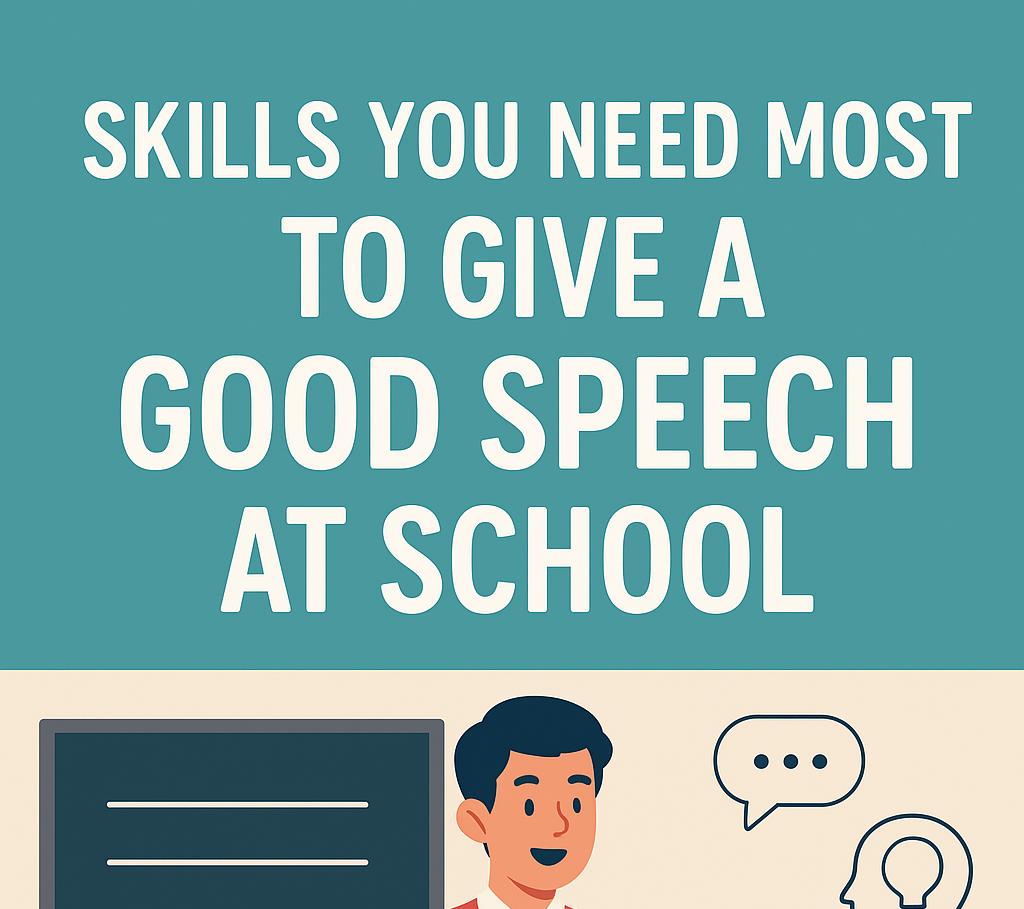A speech is a structured, spoken communication delivered to an audience. Public speaking refers to delivering a speech to a live audience, often in a formal or semiformal setting, with the intention to inform, persuade, entertain, inspire, or motivate. Public speaking is different from everyday conversation, it tends to be more planned, structured, and aimed at a larger audience. Ancient Greece and Rome considered rhetoric and oratory as essential arts of public life. Think Aristotle, Cicero etc., who framed speech as central to politics, law, philosophy. Aristotle categorized speeches into three kinds: deliberative (political, what should be done), forensic (judicial, right/wrong in past actions), epideictic (ceremonial or demonstration, praise/blame etc.).

Table of Contents
In time of globalization, public speaking takes an important role. Through the learning of public speaking skills, it would be beneficial for the students as they will be able to brush up on their personal and social interaction, academic improvement and most importantly on their career benefits. From the practice of public speaking, a student will be able to build up confidence in persuading others more effectively on the ideas and opinions that they would like to share. Besides, in an academic setting, being involved in public presentations and group discussions are common activities that a tertiary student need to master
Purposes of a Speech
A speech can have one or more of the following goals:
| Purpose | What it tries to do |
|---|---|
| Inform | Educate audience about facts, ideas, or new knowledge. |
| Persuade | Influence opinions, attitudes, or actions. |
| Entertain | Provide enjoyment; amuse the audience. |
| Inspire / Motivate | Encourage the audience to feel or act in some positive way. |
| Celebrate / Commemorate | Mark an event, honor someone/something. |
Skills do you need most to give a good speech at school
- Clarity of Thought / Knowing Your Content
- Know exactly what you want to say: your main points, examples, and structure.
- Research well so that you’re confident about facts, data, stories, etc.
- Helps avoid stumbling, long pauses, or going off-topic.
- Organization (Structure & Flow)
- A good speech has a clear beginning (introduction), middle (body), and end (conclusion).
- Transitions between ideas should be smooth, so the audience can follow your points easily.
- Time management: make sure your speech fits the time limit. Practice will help with that.
- Confidence & Overcoming Nervousness
- Public speaking can be nerve-wracking. Techniques like deep breathing, visualization, or rehearsal help.
- The more you practice, the more comfortable you become.
- Voice Control / Speech Delivery
- Speak clearly: good diction, pronounce words well. Avoid mumbling.
- Vary tone, pitch, pace. Monotone speeches quickly lose the audience. Make important parts stand out.
- Use pauses for effect (after important points) and to let the audience absorb what you said.
- Body Language & Non-verbal Communication
- Maintain good posture. Stand straight, avoid fidgeting.
- Eye contact: look at different parts of the audience instead of staring at notes. Helps build connection.
- Gestures and facial expressions that match what you’re saying. They emphasize and make your speech more engaging.
- Audience Awareness / Adaptation
- Know who your audience is (classmates, teachers, etc.): what they know already, what they expect. This helps in choosing words, examples, tone.
- Adjust as you go: if people look confused, maybe slow down; if they seem restless, include a story or joke.
- Language & Expression
- Use simple, clear language. Avoid too many complex words unless needed.
- A good speech often includes stories or examples which people can relate to. Helps make it memorable.
- Practice & Feedback
- Rehearse your speech multiple times. Practicing in front of friends/family, or even recording yourself helps you spot weak spots.
- Get feedback and be willing to revise: change what doesn’t work.
- Managing Nervousness / Stage Presence
- It’s normal to be nervous. Use breathing techniques. Prepare mentally.
- Move naturally, avoid hiding behind lectern, use the space if allowed.
- Ending Strong
- Finish with a conclusion that reinforces your main message. Possibly a call-to-action, or something memorable (quote, story, question) to leave an impact.
Types of Speech
Here are common categories you might come across:
- Informative speech
- Persuasive speech
- Ceremonial / Celebratory (or Epideictic)
- Special occasion speeches (weddings, farewells, award acceptances)
- Motivational / Inspirational
- Demonstrative (showing how something works)
- Impromptu speaking (little preparation)
- Extemporaneous speaking (prepared but delivered somewhat spontaneously)
Public Speaking Anxiety

Public speaking anxiety, a common form of social anxiety, poses significant challenges for many individuals, and the impact is even more profound for adults with speech impairments.. Public speaking can be a fundamental part of day-to-day existence and is essential for proficient, instructive, and individual settings. For people with speech weaknesses, in any case, the experience frequently includes apprehension about judgment as well as the battle to be perceived, which might compound sensations of nervousness, shame, and social separation (Iverach et al. 2014). Psychological interventions, especially those tending to nervousness and self-viability, are progressively perceived as powerful apparatuses for diminishing public speaking uneasiness and working on personal satisfaction in people with communication problems (Alladin, 2015).
The term “Anxiety” is a very common word known to all of us. In this context, there is also another term that we encounter quite often “Speech Anxiety”. Digging deep into the route cause, it is generally faced by those individuals who are not stage free and eventually tries to deliver a speech on a public platform. Speech anxiety can also be termed as “Glossophobia” derived from Greek words glōssa meaning tongue and phobos meaning fear or dread.
Whether you call it speech anxiety, communication apprehension, fear of public speaking, or just plain fear, one thing is certain, the majority of people experience the same thing when speaking to a group of people in a formal setting. Sometimes just the thought of giving a speech makes us feel uncomfortable. Sometimes those feelings manifest into physical reactions such as sweating, stuttering, flushness, and dizziness. Often we forget what we are going to say, feel unprepared and unsure, and just want the experience to end. With information, experience, and self-confidence, however, you can reduce these experiences and
How to Overcome Public Speaking Anxiety
Observing how others communicate effectively can help you improve your own communication skills. For the socially anxious individual, communicating with others might seem daunting and nerve-racking. Shyness and fear of embarrassment might prevent you from striking up conversation with classmates and/or co-workers. However, improved communication skills can be achieved, although it will take effort, practice and commitment to overcome your nervousness.
1. Observe How Others Communicate
Observe how others around you communicate with each other. Listen to how they make conversation. Specifically, think about how they initiate and continue communication through verbal cues. Make note of what they talk about, as well. You can apply what you learn from others to your own conversations.
2. Develop a List of Things to Talk About (Conversation Starters)
Paying more attention to the news would be an advantage, as this would give you subjects to chat about. For example, a new YouTube video that has suddenly gone viral can serve as a topic of discussion. If you are going to a party or an event, be prepared with a list of topics that everyone can talk about, so that you can find common ground with others. A funny topic works best, since people will really enjoy the conversation.
If you have run out of ideas for conversation starters or draw a blank, you can even make a casual remark, such as, “I heard it’s going to rain today — it’ll be the fifth day in a row!” This will be a cue for the other person to respond and will give you the chance to strike up a conversation.
3. Practice Every Day Conversations
Practice every day conversations by initiating little chats with people whom you interact with during errands. These can include grocery store clerks and bank tellers. Ask them simple questions, such as, “How’s your day going?” Or make little remarks, such as, “The bank isn’t too busy today.” These little conversations will help you build your confidence level to a point where you will feel less anxious about communicating with others.
4. Listen Attentively and Respond Appropriately
When communicating with others, listen attentively to what they say and show genuine interest. Listening will help you understand what they like to talk about. Respond by asking them questions, which will allow them to continue talking about themselves. This is good conversation practice for socially anxious people who are not comfortable speaking.
However, it is necessary to contribute to the conversation by commenting or giving feedback, so as to stimulate the other person’s interest in you. Ask open-ended questions — not ones that result in yes-or-no answers, but rather detailed answers. Once you feel more comfortable talking, you can share your personal experiences/feelings and tie them in to what the other person is saying. For example, if you ask the other person about her trip to Costa Rica, you can respond by talking about how you would like to take a vacation someday soon.
5. Use Proper Body Language
Maintaining good eye contact may make you feel nervous, but it will help you feel more connected to the other person. You can use gestures when you speak (but don’t overdo it), such as simple hand movements when you’re telling a story. Avoid crossing your arms, as this makes you look defensive.
6. Keep Smiling and Act Confident
Keep Smiling and act confident when you’re communicating with others. Positive affirmations will also help you avoid negative thoughts, such as feelings of embarrassment.
Practice is another critical component of planning for a successful speech. Even if you know and like your topic, you will still need to practice. You must practice for time, content, and delivery. Your speech must not be too long or too short but should fall within an acceptable range for the purpose of the speech. In conclusion, most people experience speech anxiety to some degree.
Learn to think of the arousal associated with public speaking as excitement rather than anxiety so that you feel enthusiastic about public speaking rather than nervous. Engage your audience in an interactive presentation that reflects your plan and preparation. In short, if you can understand what speech anxiety is, manage your physical and psychological responses, and plan a course of action you will be able to have a more positive and productive public speaking experience.
More Posts
- Virtual Reality in Healthcare, Nursing, and Medical Education
- The Role of Art Education in Early Childhood Development
Hi, I’m Anshul Patel, the creator of wiki.tigerjek.com and founder of TigerJek. I am a long-time Roblox and mobile gaming enthusiast with 6+ years of gameplay experience. I test every method, build, and strategy personally before writing guides for TigerJek. My goal is to simplify complex games and help players progress faster.




